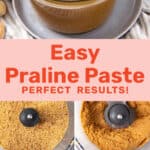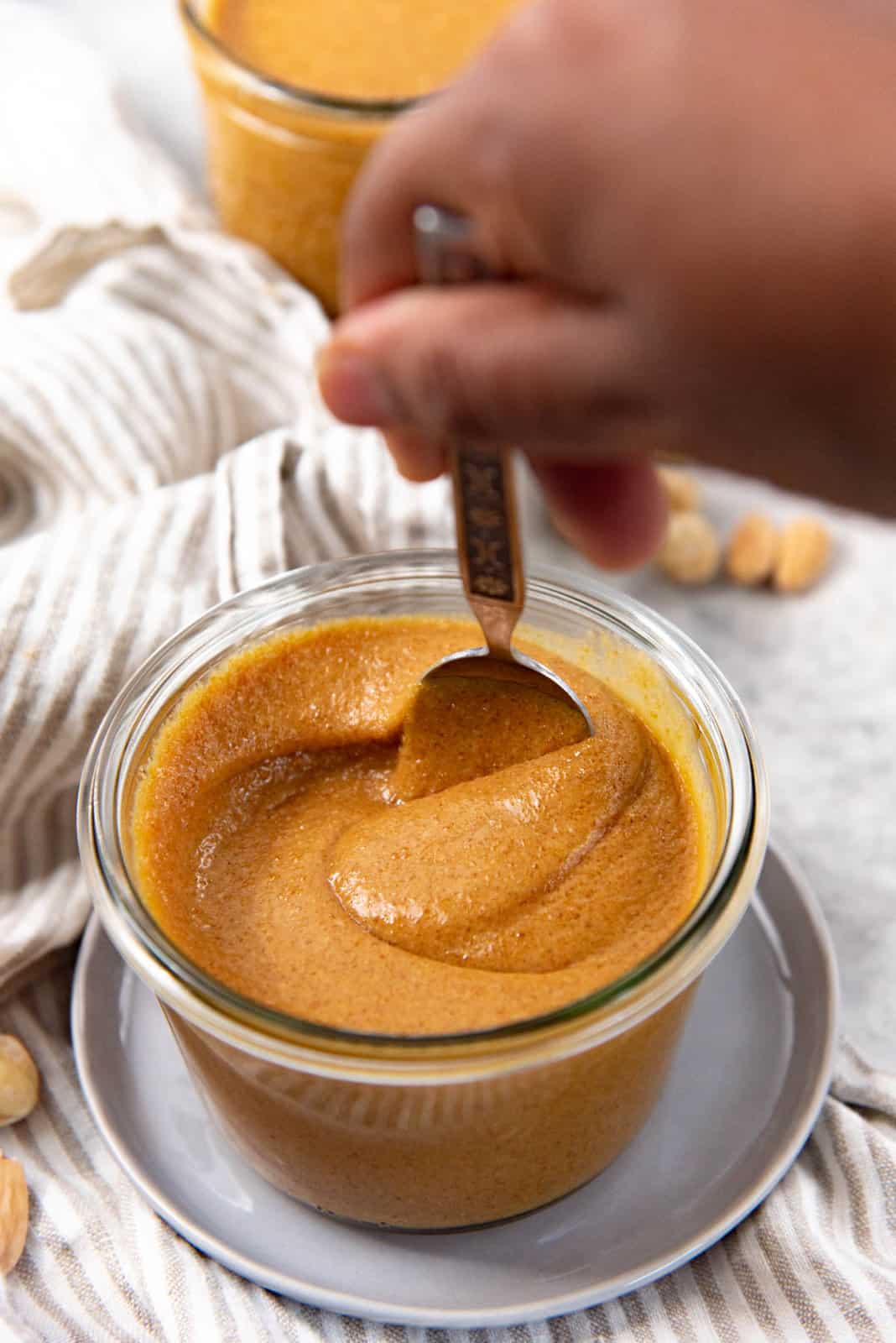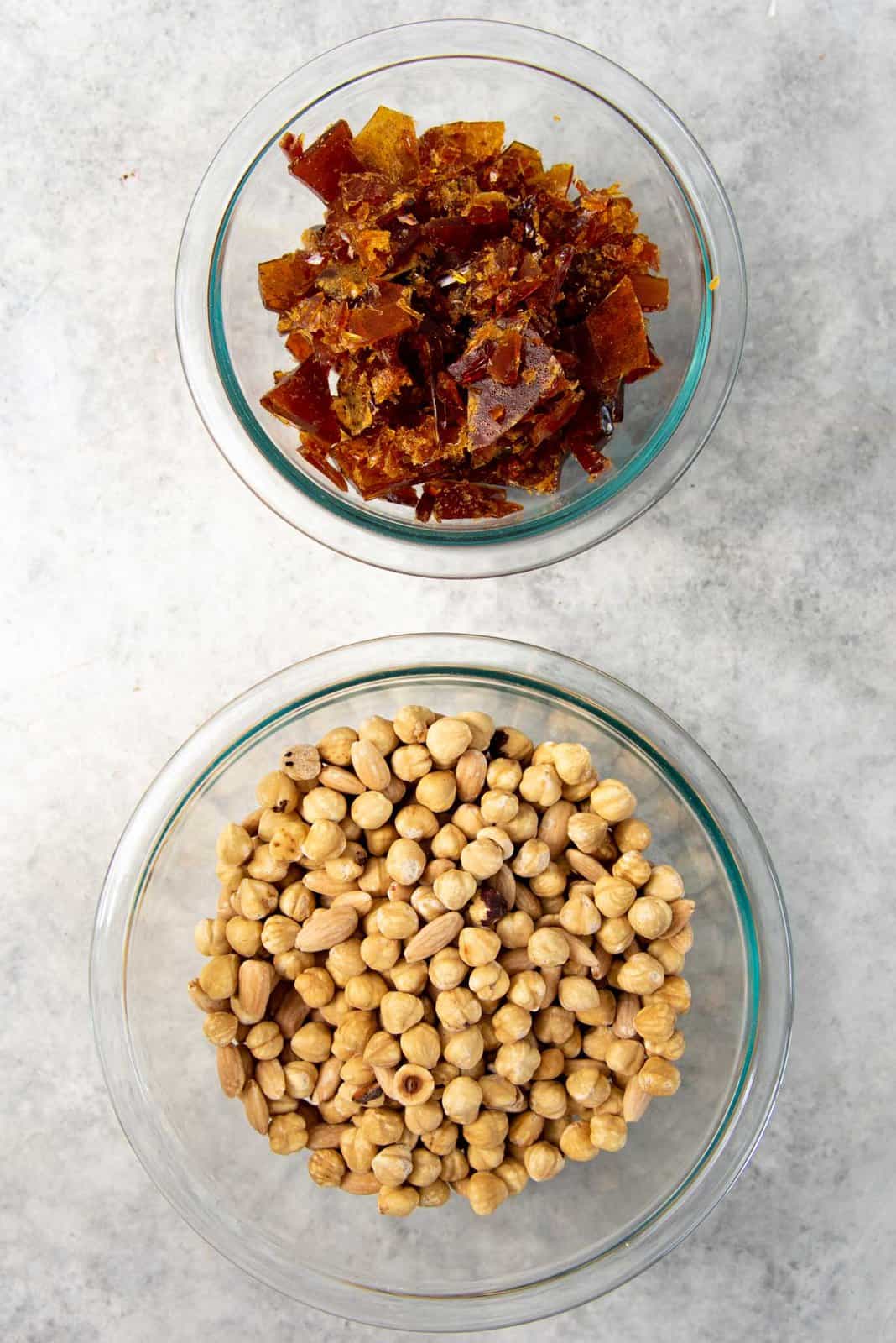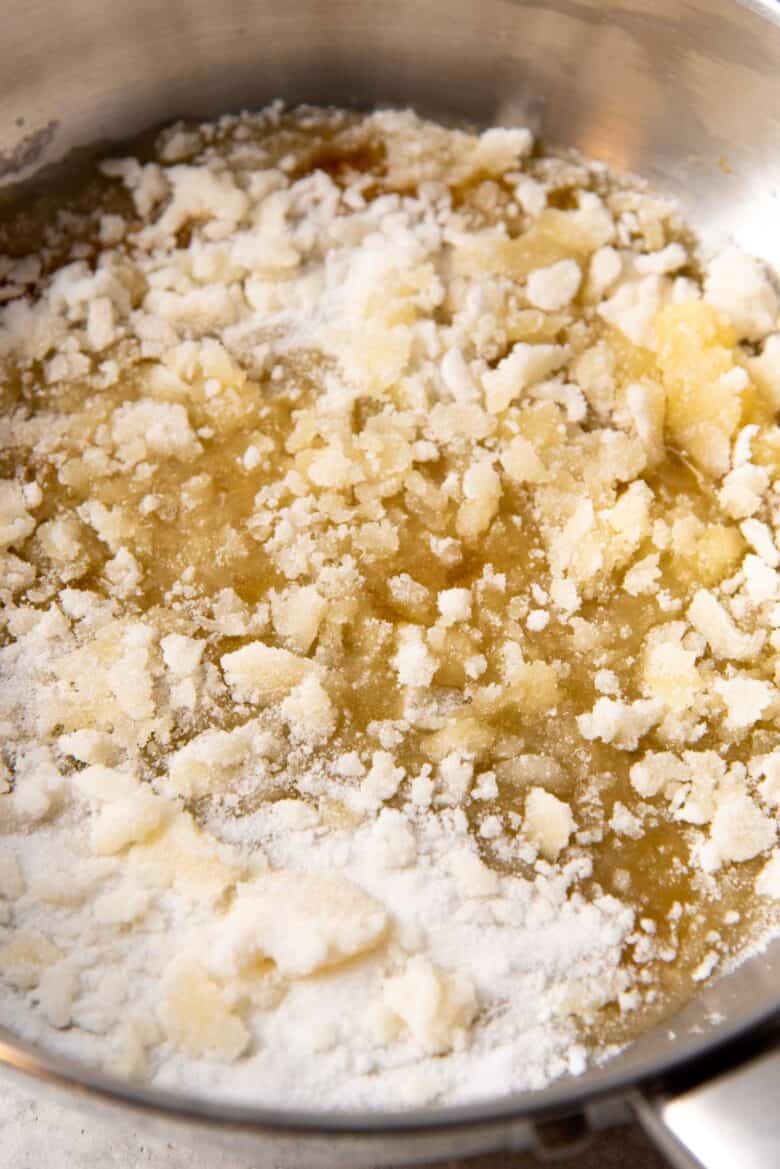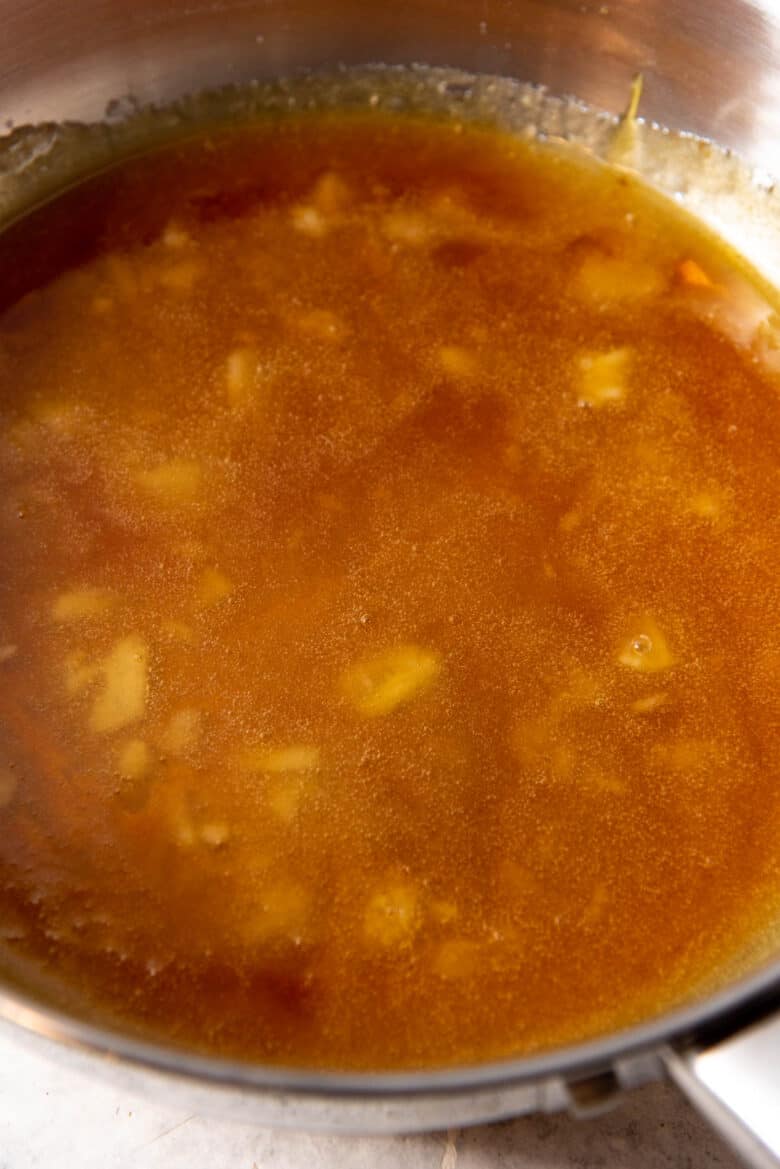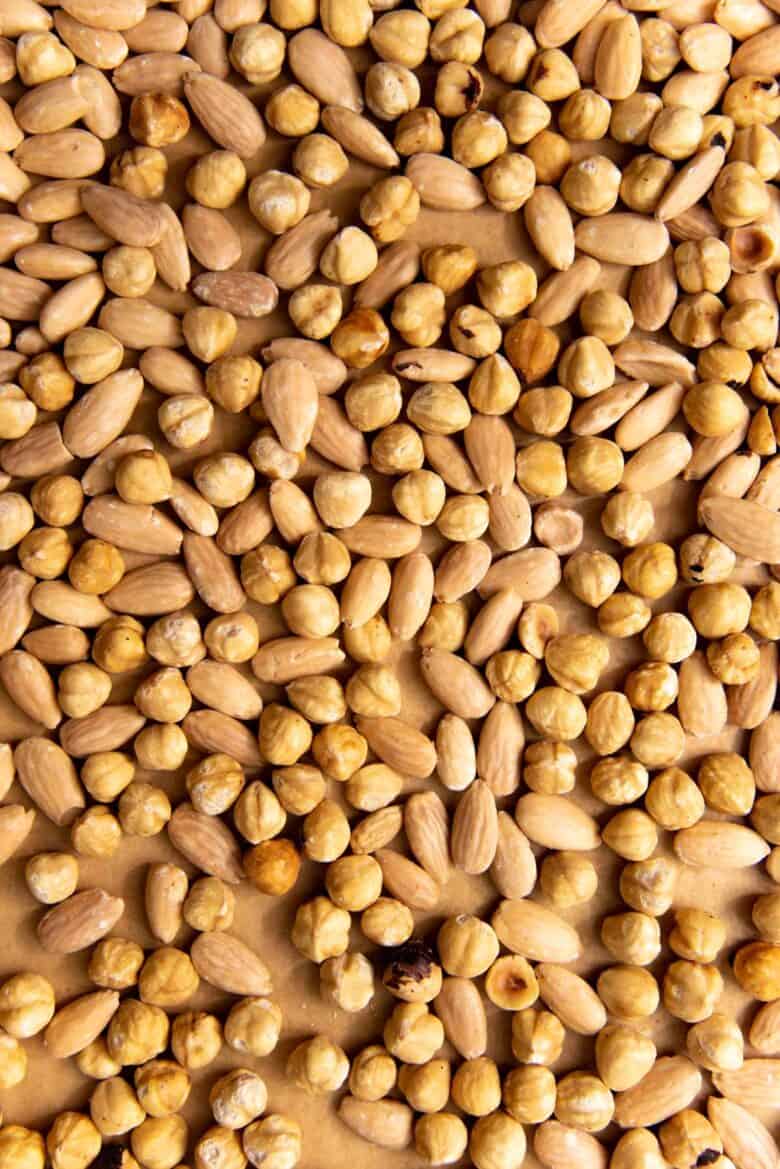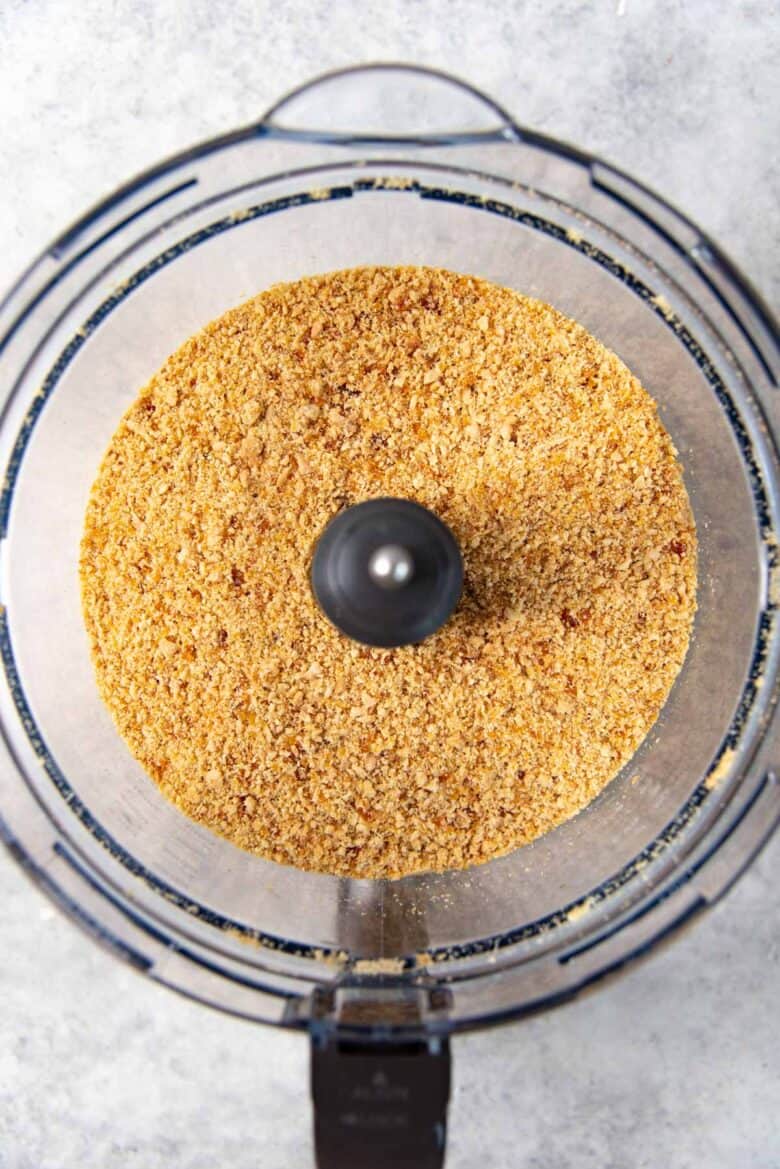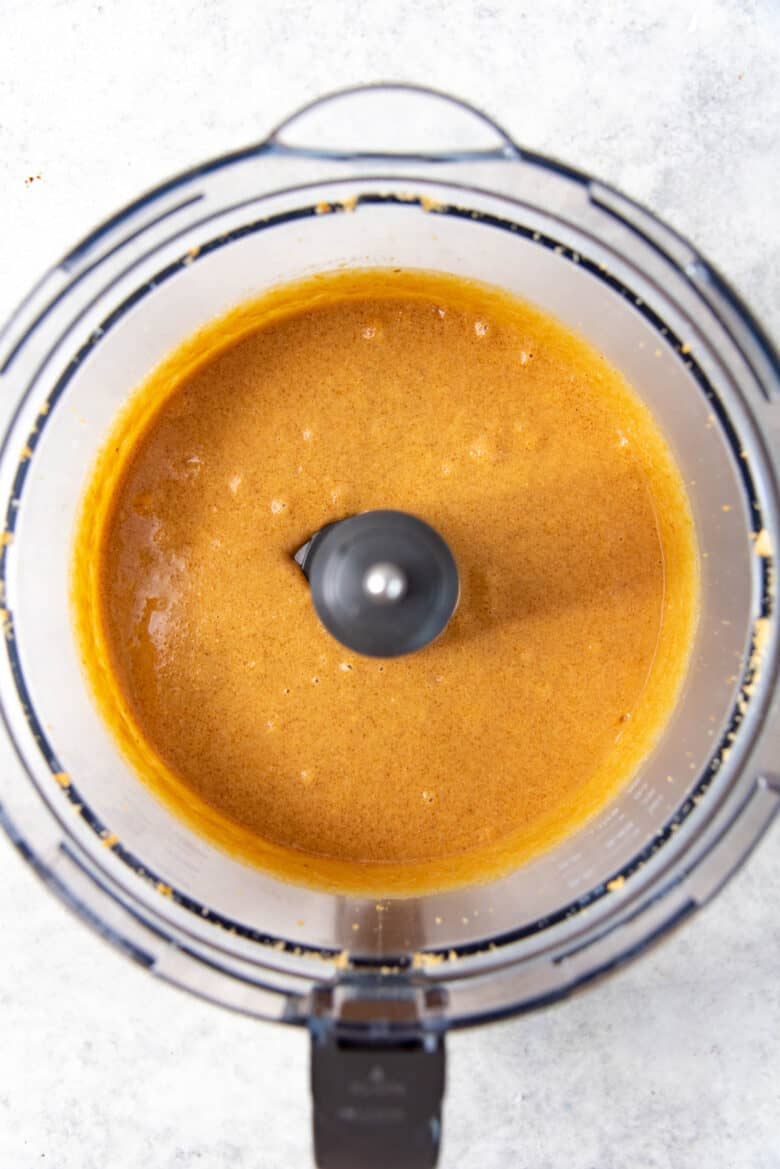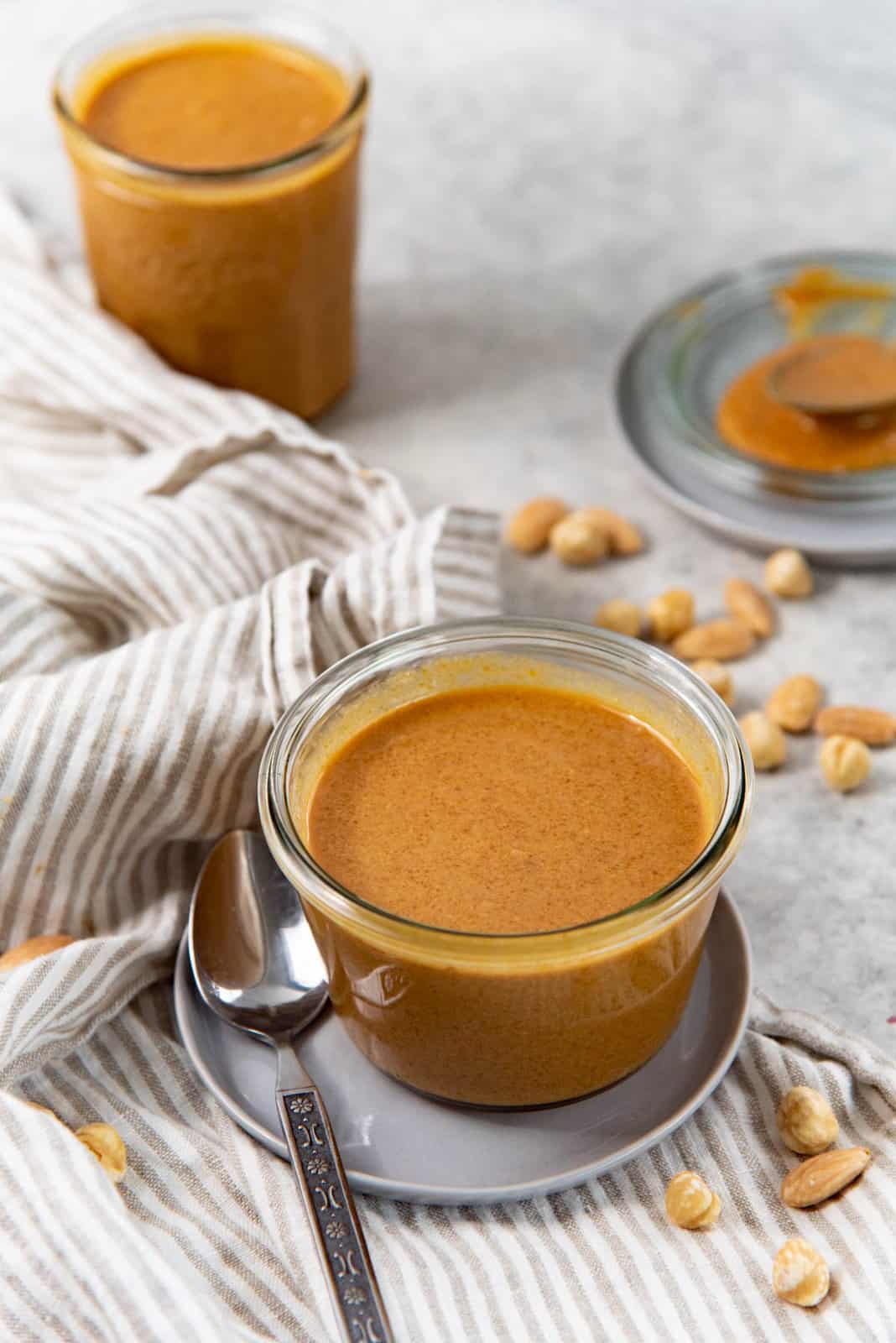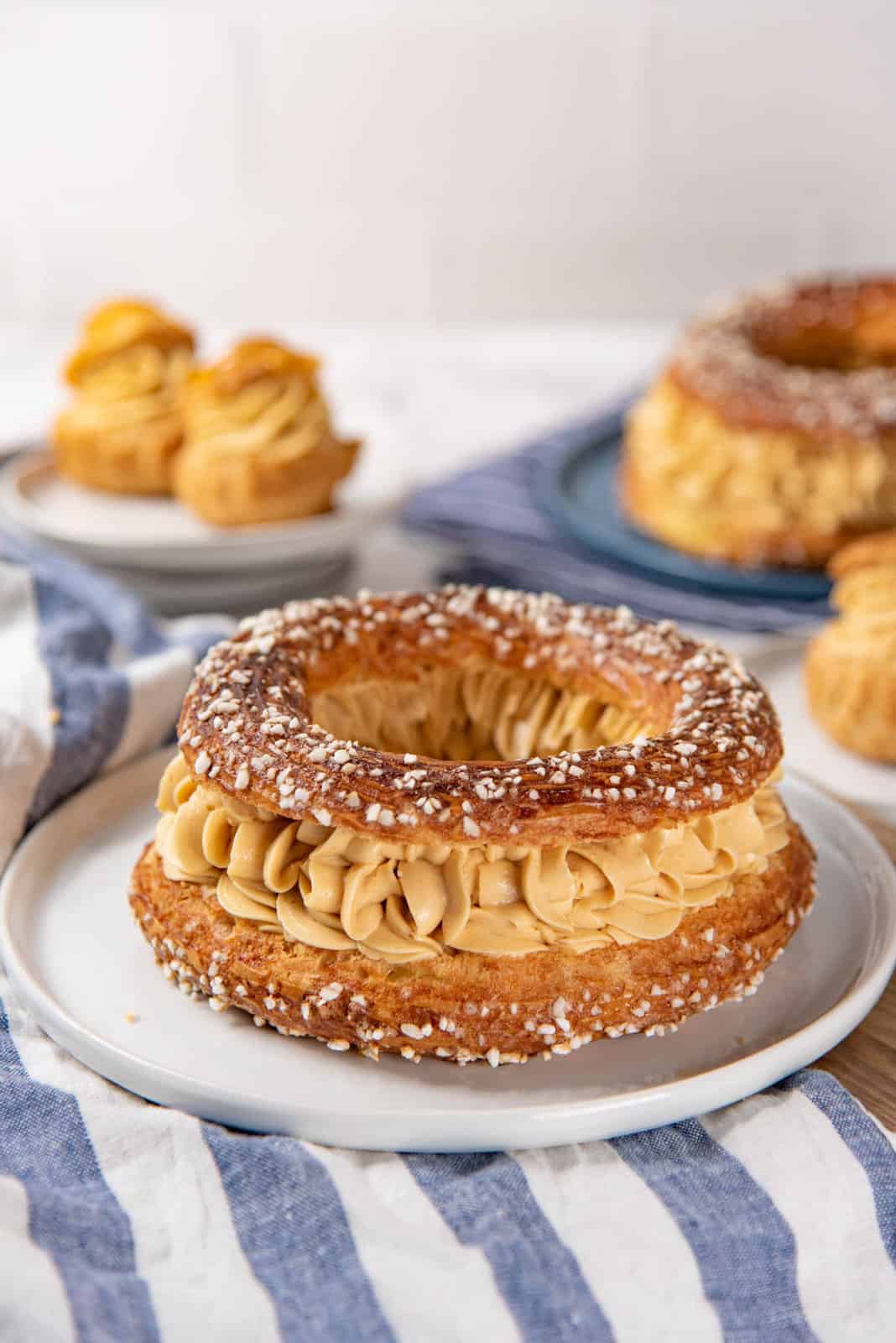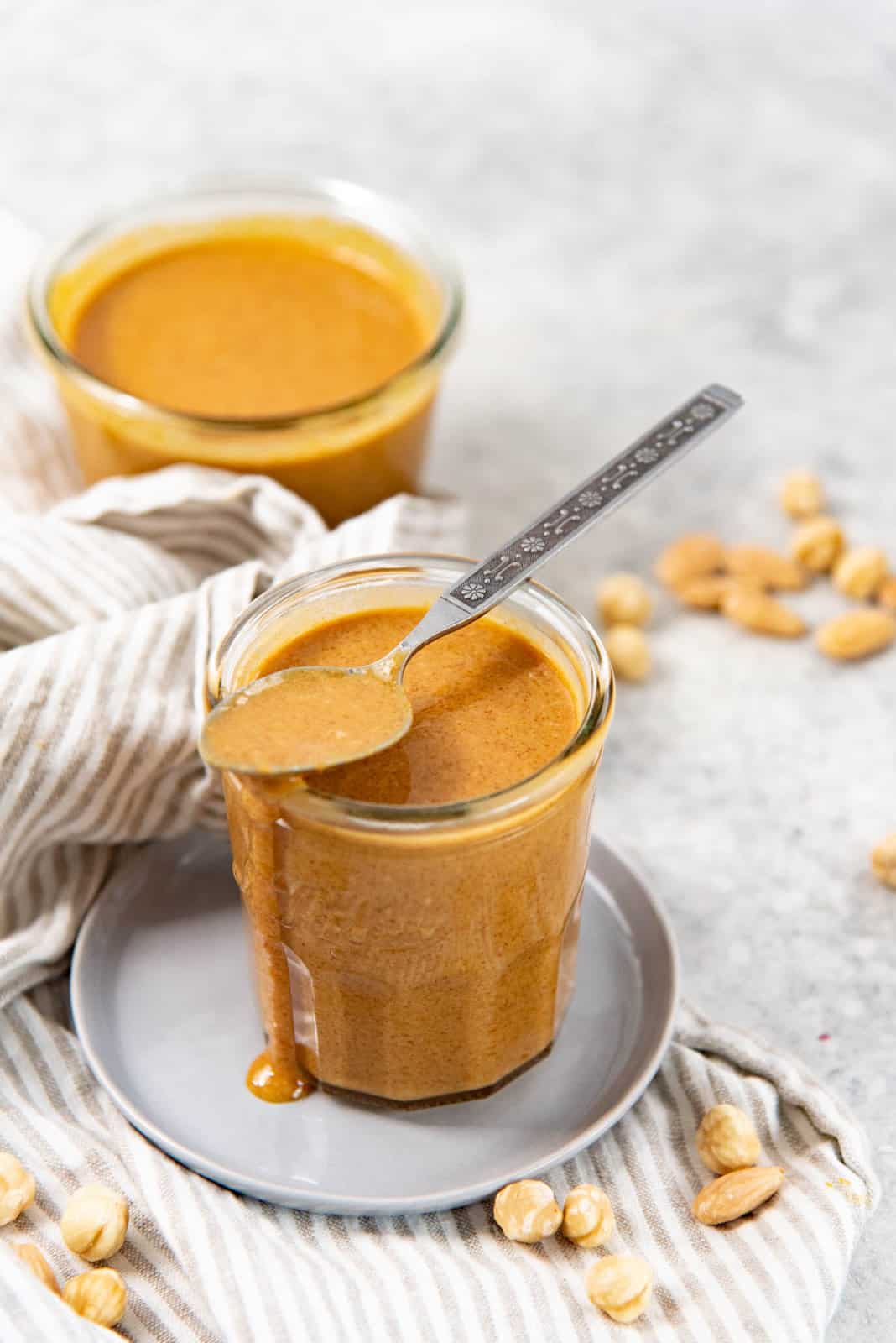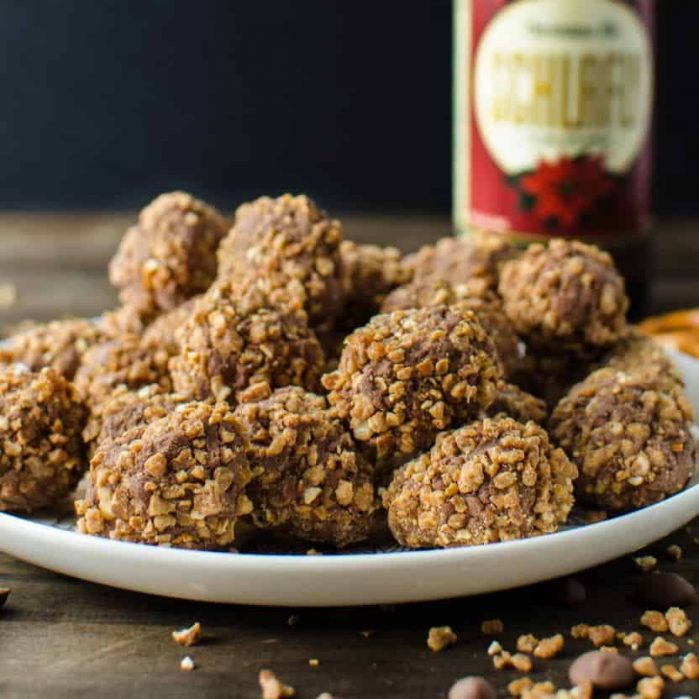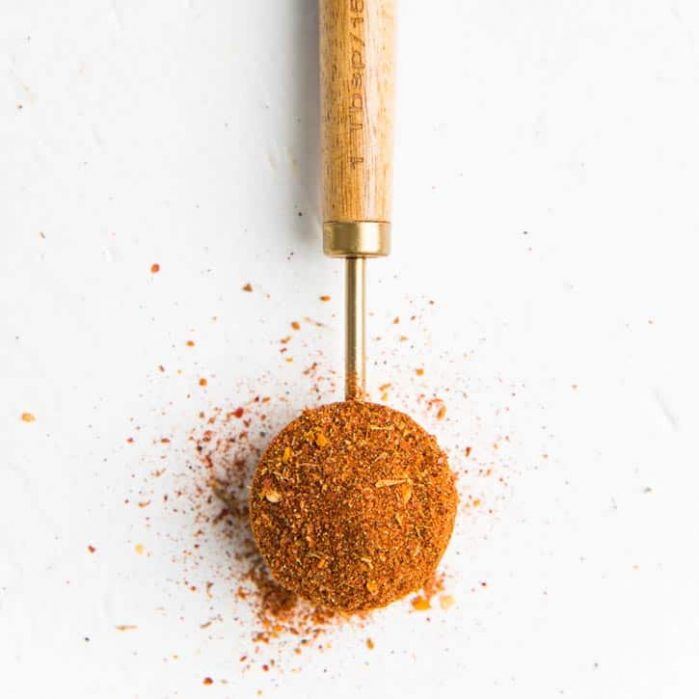A detailed, step by step recipe for a super easy way to make delicious praline paste that you can use for baking, as a spread, or as flavoring for any dessert or filling. Like this Paris Brest recipe with a praline mousseline cream filling. This recipe has been in my to-be published folder for over a year! Better late than never, right?
Why I love this recipe
This is such an easy recipe to make. I show you the shortcut to make praline paste, which still retains the texture and flavor of the classic version! Super adaptable. You can use 100% hazelnuts or 100% almonds or 100% pistachios (or you can also make my delicious pistachio paste instead)! Or you can use a mix like I did here for this almond and hazelnut praline paste. I explain the classic, authentic version, and why I prefer to use this easier version to make praline paste instead. I go through some of the common issues people encounter when making praline paste, and how to fix these. Incredibly flavorful, with the nutty, toasty flavor of the nuts, AND the sweet and bitter flavor from the caramel.
Equipment you need
Half sheet pan – For roasting the nuts. Spatula – A silicone spatula to stir the very hot caramel. A pan – Preferably a stainless steel pan so you can see the color of the sugar as it cooks. I like to use a skillet, so that the bottom of the pan is wider and the pot is shallow. A wider surface allows the sugar to have more contact with the heat and cook faster.
Ingredients for the praline paste recipe
White sugar – I use regular granulated sugar. Caster sugar will melt faster and more evenly, but I haven’t had any issues using regular granulated sugar either. So you do not have to buy caster sugar just for this praline paste recipe. Do NOT use brown sugar though – this is not what is used for a classic caramel flavored praline paste. Nuts – I use a combination of hazelnuts and almonds. I use almonds and hazelnuts at a 2:3 ratio here, with more hazelnuts. That’s simply because I love the flavor of hazelnuts more! You can decide how much of which nuts to use (almonds or hazelnuts) for this praline paste recipe. Salt – Praline paste is not complete without a little salt. Add just a touch of salt to balance the sweetness from the paste. Do not skip this ingredient because it really does deepen the flavor of the praline. For a little sweet and salty flavor combo, you can add more salt too. These are the ONLY three (or four) ingredients you need to make authentic praline paste!
Different methods to make praline paste
There are a few different ways to make praline paste. I was taught how to make praline paste the classic way. This was quite a few years ago. But through the years, I’ve changed my method and now make it this way.
Traditional method
The traditional method involves making praline. To do so, the nuts are first lightly roasted in the oven. If you use hazelnuts, the skins have to be removed as well. Next, you make wet caramel (water and sugar), and then as the sugar syrup cooks and thickens, the warm, roasted nuts are added and then this mixture is agitated very quickly with a spatula or spoon. This agitation causes the sugar to crystalize and coat the nuts. Continue to cook the sugar-coated nuts while constantly moving them around. The sugar will change color and turn an amber color around the nuts. Scrape the mixture onto a parchment paper-lined baking tray and let it cool, and then break up the nuts. Now you have classic praline nuts. Place these in the food processor, and process until you have a paste. Now you have praline paste! This traditional method is fairly difficult. The nuts and caramel need to be mixed and monitored the whole time to get the correct level of caramelization. You also have to be quick so that the sugar can crystallize as well. And especially if you’re a beginner, there’s a high likelihood of you burning and hurting your hands! This process is really not worth the effort, if you don’t want to have nut pralines (and only want the praline paste).
Easy method
Essentially, the praline paste is made out of,
Caramel Roasted nuts
So, you can make each component separately, and then process them together to get the same end result – praline paste! With this easy recipe for making praline paste, the caramel is made with the dry caramel method that does not use water. What that means is that the sugar is added into the pan with absolutely no other ingredients, and heated to melt and caramelize. I personally prefer this method of caramelizing sugar because it’s faster and there’s less chance of the sugar re-crystalizing.
Step by step easy praline paste with hazelnuts and/or almonds
Caramel component
The first step is to line a baking tray with parchment paper or silpat. It’s important that the tray is kept on a heat-proof surface, so use a trivet under it if necessary.
Next, place the sugar in a large, shallow pan that is preferably made from stainless steel. A larger cooking surface will help cook the sugar more evenly since the sugar will be in a thinner layer.
Sprinkle the sugar over the surface of the pan and heat over medium heat. You will also need a heat-proof rubber spatula.
Also, PLEASE DO NOT TOUCH THE CARAMEL! It is extremely hot and you will burn yourself if you come into contact with it.
As the sugar heats, the sugar layer touching the hot surface of the pan will start to melt and become a clear liquid. Using the spatula, move the sugar around to allow the rest of the sugar to start to melt as well. If the sugar is turning yellow or amber too quickly, remove the pan from the heat and gently stir the mixture. You can also lower the heat to slow down the cooking process.
The sugar mixture should largely be turned into a light colored caramel with big chunks of sugar. You can gently break the sugar lumps with a stainless steel spoon and continue to mix to dissolve the lumps and caramelize the sugar.
As soon as the caramel turns amber color, pour the caramel over the parchment paper or silpat. The caramel may darken in color a little at the beginning. If you want the caramel to have more sweetness and less caramel, then you can remove it from the heat when it’s a little more light in color. The darker the caramel, the bitter the caramel notes will be in the praline paste – which I personally prefer. But you do you!
Allow the caramel to completely cool down, and harden.
Preparing the nuts
I use skinned raw hazelnuts for convenience. But you can use hazelnuts with the skin on. Here’s how to remove the hazelnut skin.
Method one – Oven roasting
Place the hazlenuts on a baking tray (lined with parchment paper or foil for easy clean up). Roast the nuts in a preheated oven (350 F) for about 10 – 15 minutes. This will toast the hazelnuts AND dry out the outer skin. Remove the hazelnuts from the oven and let them cool for a few minutes. While still fairly hot, transfer the nuts onto a large dish cloth, and fold it over to enclose the hazelnuts. Agitate the hazelnuts inside the dishcloth by moving them around vigorously moving them around (like rolling with a rolling pin). Uncover the hazelnuts. Most of them should have their skin removed at this point. Repeat, as needed, with just the hazelnuts with the skin on to remove the skin from all of them. A few might be stubborn and that’s OK. The skinned nuts are now ready to be used! They should be toasted already, but if you feel like they could be roasted a little bit longer, return them to the oven to roast for just a few more minutes.
Method two – Boiling
This method works for hazelnuts AND almonds. Bring a pot of water to a boil. When the water is boiling rapidly, dunk the nuts in the boiling water and let them blanch for about 1 minute. Remove the nuts from the water and rinse with cold water to immediately cool down. Next, press each individual nut, and the hazelnut (or almond) should slip right out of its skin. Place the skinned nuts on a dish cloth and pat dry.
Roasted nuts component
Preheat your oven to 350 F / 180 C. Line a half sheet baking pan (or any large oven-safe tray) with parchment paper. Spread your choice of nuts out in a single layer. I used 300 g hazelnuts and 200 g almonds here. Use all hazelnuts for a hazelnut praline paste, or all almonds for an almond praline paste. For pre-skinned raw whole nuts – Roast the nuts in the preheated oven until the nuts are lightly toasted. This can take anywhere between 10 – 20 minutes, depending on the size of the nuts. So keep an eye on them and stir the nuts so that they roast evenly. If you roasted the hazelnuts to remove the skin, OR you have sliced or slivered nuts, this roasting time will be much less. So keep an eye on them and do not let the nuts burn. If you boiled the nuts to remove the skin, you will need to roast the nuts longer, to allow them to dry out first and then roast / toast. Once the nuts are toasted, remove them from the oven and let the nuts cool down until you’re ready to make the praline. Alternatively, you can also pour the caramel all over the roasted nuts and let the caramel set over the roasted nuts. Either way should work in the end.
Making the praline paste
Break the caramel into smaller pieces. The caramel may be hard to break if it’s a fairly thick piece. I cover the caramel piece with another piece of parchment paper and then whack it against the countertop. After it breaks into larger pieces, then I use a heavy object and break it into smaller pieces. If you coated the nuts with the caramel, you can do the same thing to break ’em up. The nuts do make it easier to break up the caramel, since the nuts are the “weak spots” and you can use a knife to cut through them. Place the roasted nuts and caramel pieces in a food processor or blender. Make sure the food processor or blender is powerful enough to be able to make nut pastes. This will ensure that you end up with a smooth praline paste. Add some salt to the nuts and caramel. Process the nuts and caramel until you have chopped all of it until they are all very finely chopped. This is the first stage. Process it for a total time of about 4 – 5 minutes until you have an incredibly smooth praline paste. At the 3 minute mark, you can taste the paste and add a little more salt IF you prefer. The processing time will vary depending on your food processor or blender. If you have a less powerful food processor, then it’ll take longer to make the praline paste. After processing for about 1.5 – 2 minutes, you should have a very thick, grainy praline that is mostly sticking together with some dry nut mixture in there as well (resembling coarse sand). After about 3 minutes, the praline paste will look very thick and sticky. Almost like a thick peanut butter. You can stop here if you like if you prefer a thicker paste. There could still be some smaller pieces of nuts and caramel pieces though. At 4 minutes, the praline paste is very smooth and still thick, and would start to feel a little warm. The praline paste is perfect at this stage as well. However, I want my praline paste to be less thick. Which is why I process my praline paste for 5 minutes. At this stage, the praline paste is very warm. The warmth of the nuts help release more of the oil within them, making the paste smoother and more fluid. The paste WILL thicken as it cools down.
Storage
When the almond and hazelnut praline paste is ready, scrape it all into prepared jars or containers. Make sure the containers are air-tight, with tight-fitting lids. More importantly, also make sure the jars are clean and dry prior to filling them with the praline paste. The praline paste should last about 4 – 5 months in the fridge, IF it is stored properly. If you use dirty spoons to use the praline, or leave it out for prolonged periods of time in between refrigeration, the paste will obviously spoil sooner. I always check if the paste looks good, has no off smell, and the texture is normal, before using. Especially if I keep the praline paste in the fridge for longer than a month. Usually, I prefer to store my praline paste in the freezer if I know that I won’t be using it right away. I’ve kept praline in the freezer for up to 18 months (without thawing and re-freezing) and have had NO issues with the taste and texture. But it is important to keep it in an air-tight container so that it won’t pick up any other freezer smells.
Praline paste adaptations
Add a little bit of cocoa powder while blending the paste to add some chocolate flavor. Hazelnut praline with cocoa powder will definitely taste like an elevated, high end Nutella paste. You can also add some vanilla to add depth of flavor. Coffee praline paste is also a fantastic variation. Instant coffee granules will add an extra bitterness to the praline paste with the coffee flavor.
How to use the paste
As a paste – Spread praline on toast for a delicious sweet toast snack! If you like Nutella and peanut butter (or almond butter), then you’ll love praline spread on toast! Flavoring – Add praline paste to buttercream frosting recipes, whipped cream, or even custard desserts to make flavored fillings and toppings! Imagine adding praline into your vanilla ice cream base? Nutty, sweet vanilla praline ice cream will be your next favorite ice cream flavor! This mousseline cream recipe is the perfect example of how to use praline to flavor a filling. Filling – It can be used just as is, as a filling! How about praline filled chocolate truffles or bon-bons? Pipe it into the middle of croissants to make praline filled croissants or praline filled pastries! Baked goods – Add praline into the middle of cinnamon rolls for praline bread rolls. Or how about cake recipes with praline added to the batter?
Frequently asked questions
